Samsung Galaxy Nexus & Ice Cream Sandwich Review
by Brian Klug & Anand Lal Shimpi on January 18, 2012 1:34 PM ESTDisplay
Another huge axis of improvement lately has been the mobile display category. It’s an ironic turn of events which has led to the mobile side being where all the improvement is taking place for displays in general. On one side of the industry we have the PC display market, which is currently locked in a dramatic race to the bottom (1080p 27" displays, decline of the 16:10 aspect ratio, etc.), and on the other side we have mobile displays where OEMs are rushing to outdo each other every major product cycle. In fact, 2012 might go down as the year when mobile display resolution eclipses the desktop.
Back on topic however is the Galaxy Nexus display - it’s a 4.65" diagonal, Super AMOLED HD 1280x720 affair. If you’ve followed Samsung’s AMOLED naming scheme, you can pretty much tell everything that there is to superficially know about the display just from the name. Super connotes an optical bonding (read: no air gaps or their pesky 4% Fresnel reflections) of the display and the entire stack above it, consisting of capacitive layer and top glass.
HD connotes, well, 720p HD, and finally the absence of Plus connotes the presence of PenTile RGBG. On that last note, we made a prediction that PenTile would be very hard to see on the Galaxy Nexus based on some pixel pitch calculations, and this turns out to be the case.
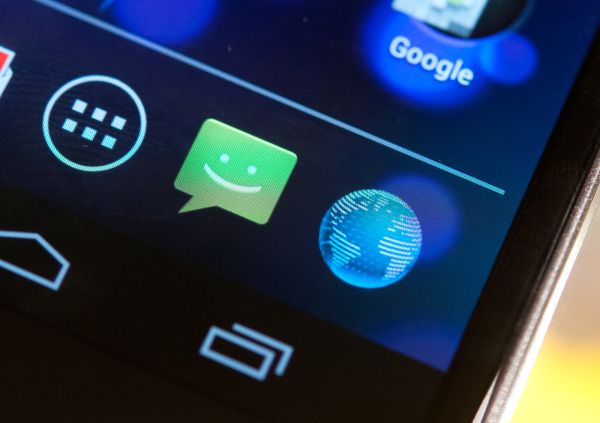
Decently close to the Galaxy Nexus display with a macro lens - hard to make out any subpixels
For me at least, the Galaxy Nexus display exceeds my visual acuity - I cannot pick out subpixels at all on the Galaxy Nexus. Quite literally, the RGBG subpixel stripe is now small enough that it is beyond visual acuity at standard viewing distance (1 foot).
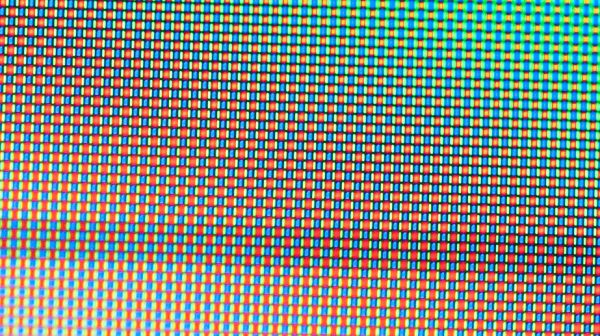
Extreme macro shot of the Galaxy Nexus' display for illustrative purposes showing PenTile RGBG
If 2011 was the year where OEMs countered the iPhone’s retina display with qHD panels, 2012 is the year where they finally start to exceed that 330 ppi number. It seems as though 1280x720 WXGA will be the new WVGA or qHD for 2012, and already there are a bunch of 720p devices arriving on the market - phones like the HTC Rezound, LG Nitro HD, Galaxy Note.
Last time we compared pixels and subpixels per inch in the diagonal on a few phones. Many people pointed out alternative ways to compute everything, but in the end the aim was to set expectations for how visible PenTile would be, and the conclusion was: not very. This time, I think it makes sense to compare the actual angular subtense of the subpixels so we can appreciate whether they’re visible or not, rather than deal with another back and forth about whether measuring along the diagonal is valid or not anymore. It's easy to be lazy and just do things entirely wrong, but the actual angular subtense of a subpixel should be the canonical measure we use to determine whether you can see pixels or not, since that's the annoyance after all. Visual acuity for the average human eye is 1 arcminute (something drilled into my head from endless optical engineering classes), and perfect human vision is just below that at around 0.7 arcminutes. I have 20/15 which puts me around 0.75 arcminutes, and I can't see subpixels on the Galaxy Nexus unless I really, really try.
It’s actually a challenging thing to codify whether or not you’ll be able to see PenTile, since color (wavelength) makes a huge difference. Further, visual acuity is itself a hard thing to qualify - for example, consider how much resolution is enough to identify versus detect something, and then how human vernier acuity (aligning something) is very good, and all of this is a function of the light's wavelength. For example, the on-off pattern when looking at solid green is just about the worst case possible - it’s a square wave (100% modulation) in the green right where the eye is most sensitive. In the past, it struck me that other members of the tech press were perhaps unconsciously taking photos of the green battery indicator to show the presence of PenTile or not since that's where subpixels are most visible. As an aside, most of the UI is now blue in 4.x (including battery indicator) which the eye does not have very good sensitivity to - just try focusing on something entirely blue - is this a coincidence or conscious decision to mask bad displays? For comparison, when displaying white obviously subpixels largely disappear into a sea of light. If you look at a green solid region now, you’d be hard pressed to make out the individual subpixels, and the table explains why:
| Display Subpixel Angular Subtense lower is better, human eye ~1 arcmin) | |||||||
| Phone | X subpixel angular subtense at 12" | Y pixel angular subtense at 12" | |||||
| HTC Rezound | 0.280 | 0.839 | |||||
| iPhone 4/4S | 0.290 | 0.869 | |||||
| LG Nitro HD | 0.293 | 0.878 | |||||
| Motorola Droid | 0.361 | 1.082 | |||||
| Motorola Atrix 2 | 0.373 | 1.118 | |||||
| Galaxy S II | 0.440 | 1.320 | |||||
| Galaxy Nexus | 0.454 | 0.907 | |||||
| Infuse 4G | 0.461 | 1.382 | |||||
| Droid 3 | 0.520 | 1.040 | |||||
| Droid RAZR | 0.559 | 1.118 | |||||
| Droid Incredible | 0.568 | 1.136 | |||||
| Nexus One | 0.568 | 1.136 | |||||
| Galaxy S / Nexus S | 0.614 | 1.228 | |||||
The interesting thing about the table is that it very much backs up my subjective impressions of just how visible subpixels were on previous phones. The Nexus S / Galaxy S had comparatively gigantic subpixels, and I can't stand looking at those displays to this day. Move up the line and you get increasingly better (I've sorted by x/horizontal angular subtense), with the HTC Rezound exceeding the iPhone 4S. Note that you have to consider the adjacent unlit subpixels as well to really arive at a conclusion for how visible things are going to be - on the PenTile RGBG displays, that means one adjacent unlit subpixel, and on RGB stripe, two unlit subpixels (assuming we're talking worst case 100% Green, 0% Blue, 0% Red).
While Samsung has been able thus far to increase its AMOLED pixel pitch considerably, it has come with one unintended effect. That effect is a bit of pixel inhomogeneity which results in a somewhat grainy look to the display under certain circumstances. While neither device we tested had it, others have reported lines or splotches. There’s a word for these inhomogeneities in display luminance, and it’s “mura.” The variance is no doubt very minor, but the eye is great at picking out these small changes, and it’s particular visible in certain contexts, like the grey loading screen on the Android Market. So far getting a good photo of this effect has eluded me, however, it looks like a light film grain. Stated another way, it's like a fixed pattern noise that exists at all times on the display, which seems particularly visible at some brightness levels. To be honest, it doesn’t annoy me any more than IPS display “grain” annoys me - you just get used to it after a while.
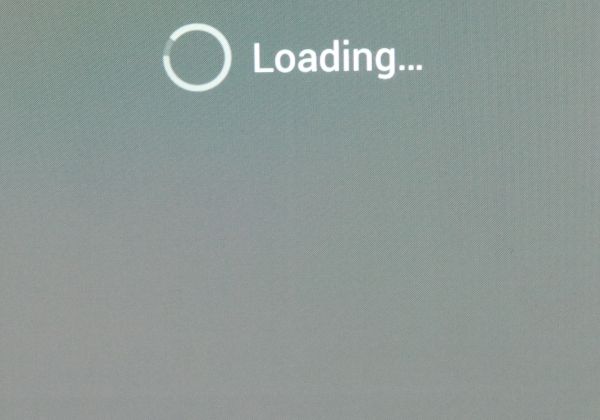
Photographing the mura on the Galaxy Nexus' display has proven a challenge
These inhomogeneities also sometimes manifest themselves as visible strips of different luminance. I haven't seen any on either of the Galaxy Nexi we have, but if you do get hardware with annoying inhomogeneities, I recommend just swapping. Again, getting photographs of the grain has proven challenging.
The display’s surface is curved, though the radius of curvature is nowhere near as curved as some of the early teaser photos would’ve had you believe. Total sag ends up being around 1.5 mm, giving a radius of curvature around 1.5 m - needless to say, it’s a very gentle curve. The other noteworthy thing about the Galaxy Nexus is Samsung’s choice of glass. Lots of people have noted that the Galaxy Nexus isn’t adorned with Corning’s popular Gorilla Glass, though it’s still a kind of fortified (and no doubt alkali-aluminosilicate) glass. It’s impossible to tell exactly what kind of glass is on the Galaxy Nexus without destructive testing on either Samsung’s or Google’s review unit. That said, if anyone breaks a display, send me the broken top glass and I’ll be able to do some compositional analysis. As an aside, compositional analysis of the top glass from different phones is something I’ve wanted to do for a while now, but requires sourcing broken glass.
We’ve also done all the usual measurements on the Galaxy Nexus - luminance and color temperature at different brightnesses selected in settings, and a run through HCFR using Francois’ excellent Screen Test Patterns app.
First off are the display charts taken at a number of different brightness settings by dragging the slider around in settings. Traditionally AMOLED has struggled to keep a flat white point. Here the Galaxy Nexus isn't bad at all, hovering just below 6500K.

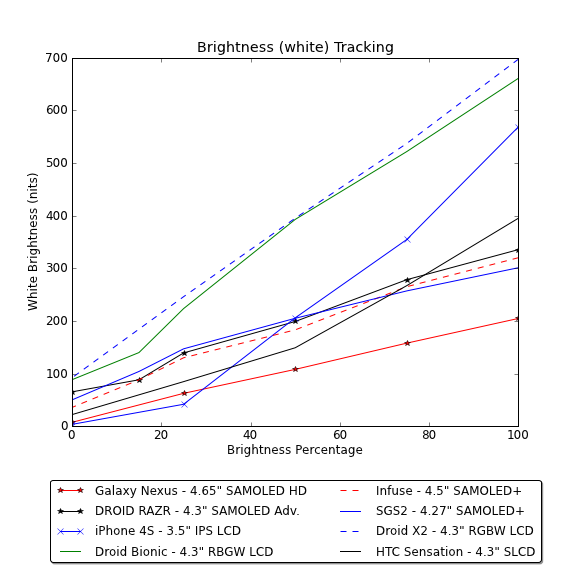
The Galaxy Nexus manages to stay reasonably close to 6500K even as brightness changes across its full range. The brightness curve is also nice and linear, though it tops out at just over 200 nits at maximum brightness.
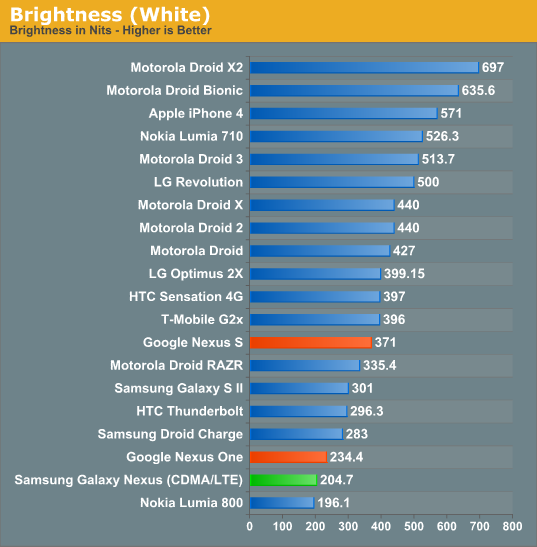
The HCFR plot and color.chc file tell an even more interesting story. The CIE chart shows how AMOLED continues to have a gamut much larger than sRGB (which is the inner triangle). It’s awesome to have more spectrum, but bad when mapping sRGB to this color space without more management, and leads to AMOLED’s oversaturation stigma.
There are more interesting things inside, too. Color temperature at 100% brightness and displaying different shades of Gray stays pretty close to 6500K as well. Gamma ends up almost all over the place, unfortunately.
The nice thing about ICS on the Galaxy Nexus is also increased color depth in many places. Previously Android’s gallery many times appeared in RGB 565, leading to visible banding. This is now almost entirely gone as well.
Viewing angles on the Galaxy Nexus, like other AMOLED devices, is superb as well. There’s practically no shift in either horizontal or vertical angles. Outdoor viewing has gotten better on AMOLED with a bunch of improvements - better AR coatings, no more air gaps, and other coatings. Out in the brightest of sunlight it can still be hard to read, however.


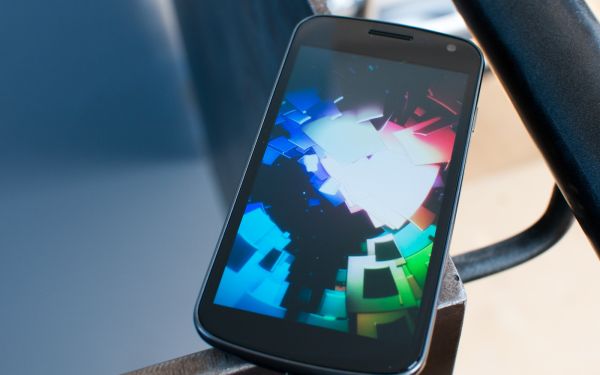
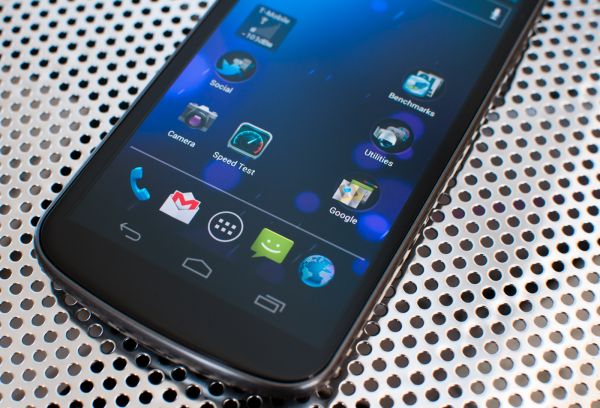





















185 Comments
View All Comments
Tujan - Wednesday, January 18, 2012 - link
Concerning the youtube video shown about the android smartphone. No misconception here,but is it the intention of the video to put your thumb so much at the forefront of the small phone,somehow toggling between 'both eyes' of the viewer. ? Is that the intention of the video ?Pure punn intended that is an awesome big speaker you are speaking to. And true even though the video was most likely rendered in 'full part',with both video and audio attached,I cannot help the feeling that there IS SOME LATENCY between my chinese made glasses and the finish of my lcd.
The fact that you are discussing a radio device,and I am utilizing a later viewing of it over a wired internet connection. Does not diminish the fact that your radio devices capability of facial recognition,and my lcds display of it is no substitute for taking x-rays if you actually need to.
I see that you are descript in functioning your arms across the whole of the screen at the making of your video. And there is that very large meter between the preposition of the distance of the audio device,and the radio device that is to conclude that preposition.
Punn accepted there is certainly some latency there that is perfectly conceptual. Between the foreground,and the background. And the autonomic acceptance of my viewing it.
You notice that at times as a forefront,you have a wide screen rendering. Then at other times there is the focus 'in'. The difference in doing so is the focal point of my comment in that subject of its latency.
And that truly the speaking IS a separate distinction of a Microphone. Than that of a speaker,and the screen displayed. Your being behind it shouldn't be misconstrued of what my comment is coordinating to account to. Since obviously the latency between my glasses and what I see on the screen at my viewing of it is of no consequence to your creation of it.
Mentioning that relationally you cannot change the environment around you no more than I can make your video for you. Perhaps someone will recognize this.
And thanks.
nsnsmj - Wednesday, January 18, 2012 - link
I always enjoy how detailed the reviews are.BitGambit - Wednesday, January 18, 2012 - link
I love this phone, but I have owned 2 different Nexii with the "Mura" screen issue. The first one I owned was glaringly obvious, but the second one less so, but it's still there. I was not able to exchange it for the second time, because the defect wasn't apparent enough to warrant an exchange, explains the Verizon employee. It pains me because having a good screen is important to me and I was looking forward to release of the Galaxy Nexus. I'm absolutely jealous of those who have a Galaxy Nexus with immaculate AMOLED screens.crankerchick - Wednesday, January 18, 2012 - link
I haven't had a chance to read the whole review, but I'm happy to see it. I've been checking everyday thinking I must have missed the review. It's great to see time and care being put into the review, as always. The video at the bottom was also very insightful and hits right in the points if why I prefer Android and the evolution it has seen, over iOS when it comes to my mobile devices. ICS flies in my Galaxy Nexus and my XOOM! I don't ever see 25 Mbps on my Nexus though, or all the bars for that matter. Maybe I have a signal issue? :-pflomt - Thursday, January 19, 2012 - link
I see you have the iphone 4s getting 9.85 hours of web browsing. Do you receive a phone from Apple to test, or do you go to the store and buy one?The reason I am asking is I have a 4s and I can tell you mine, and the people I know that have one are lucky to get 9.85 hours of battery life with the phone sitting on the nigh stand.
Thanks for the great reviews.
doobydoo - Thursday, January 19, 2012 - link
I think all the figures Anandtech post are their own measured statistics.I have a 4s and I, and the people I know that have one, are amazed by how long the battery life lasts, both in general and when web browsing.
When sitting on the night stand for 9.85 hours a very small percentage of battery life is depleted.
flomt - Thursday, January 19, 2012 - link
I know 4 other people with a 4s, none of them can last 24 hours with very light usage. 9 hours of web browsing is not even kinda of possible. All are on the most current release 5.0.1Reading the Apple forums, I am not the only one. Do the phones with poor battery life all originate in a different factory than the ones that last a long time? have a different version of the radio?
Apple is just denying that they have a problem now and I can tell you that they really do have a serious problem with some phones.
tipoo - Thursday, January 19, 2012 - link
Are you running push e-mail by any chance? That kills idle battery life.flomt - Thursday, January 19, 2012 - link
Nope, manual sync only.tom5 - Thursday, January 19, 2012 - link
You state in the article here that the camera sensor is a NOT-back-illuminated S5K4E1G sensor and Chipworks in the teardown article states that Galaxy Nexus is using "S5K4E5YA 5 Mp, 1.4 µm pixel pitch back illuminated CMOS image sensor":http://goo.gl/gvIWV
Who is right?